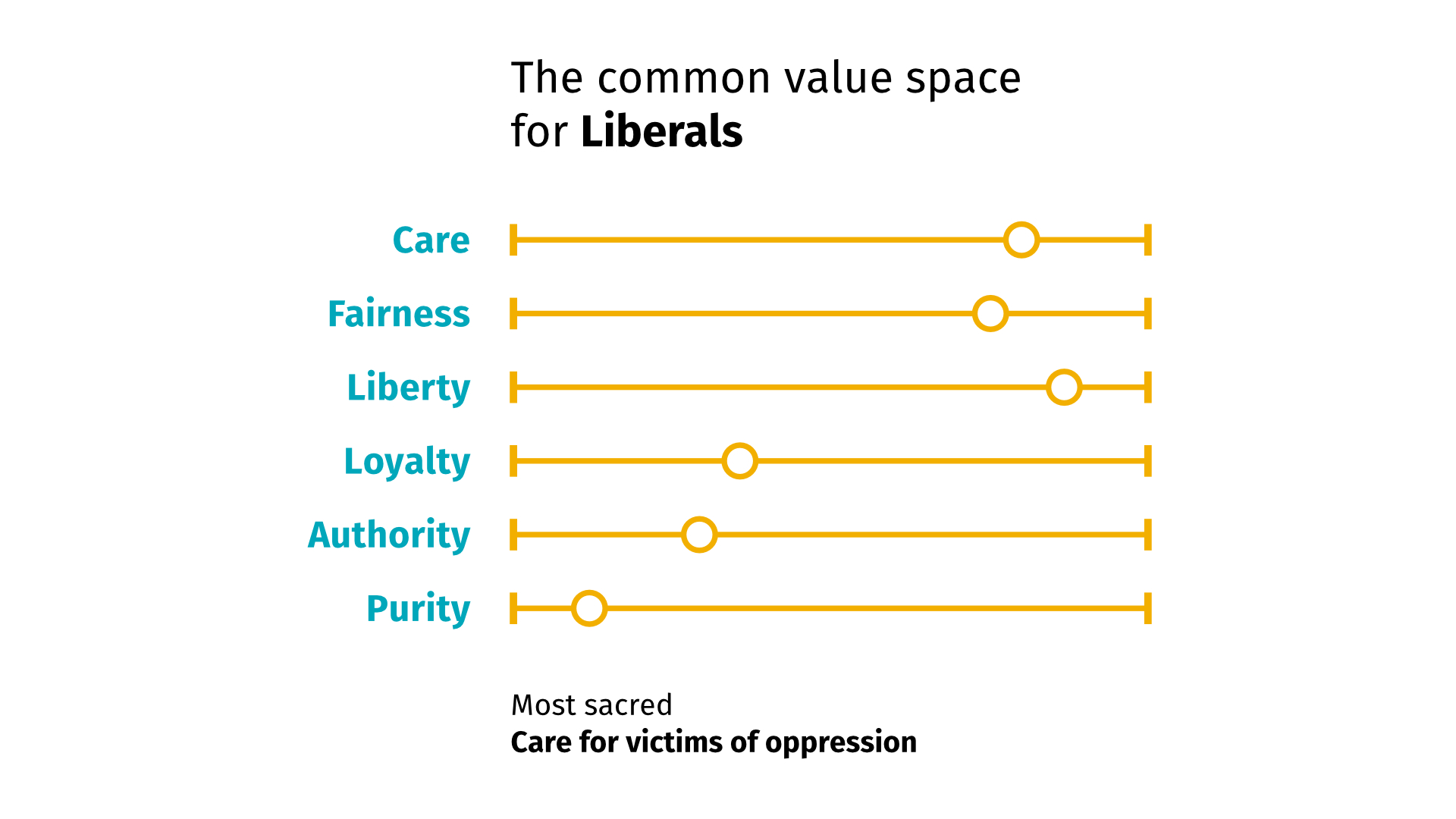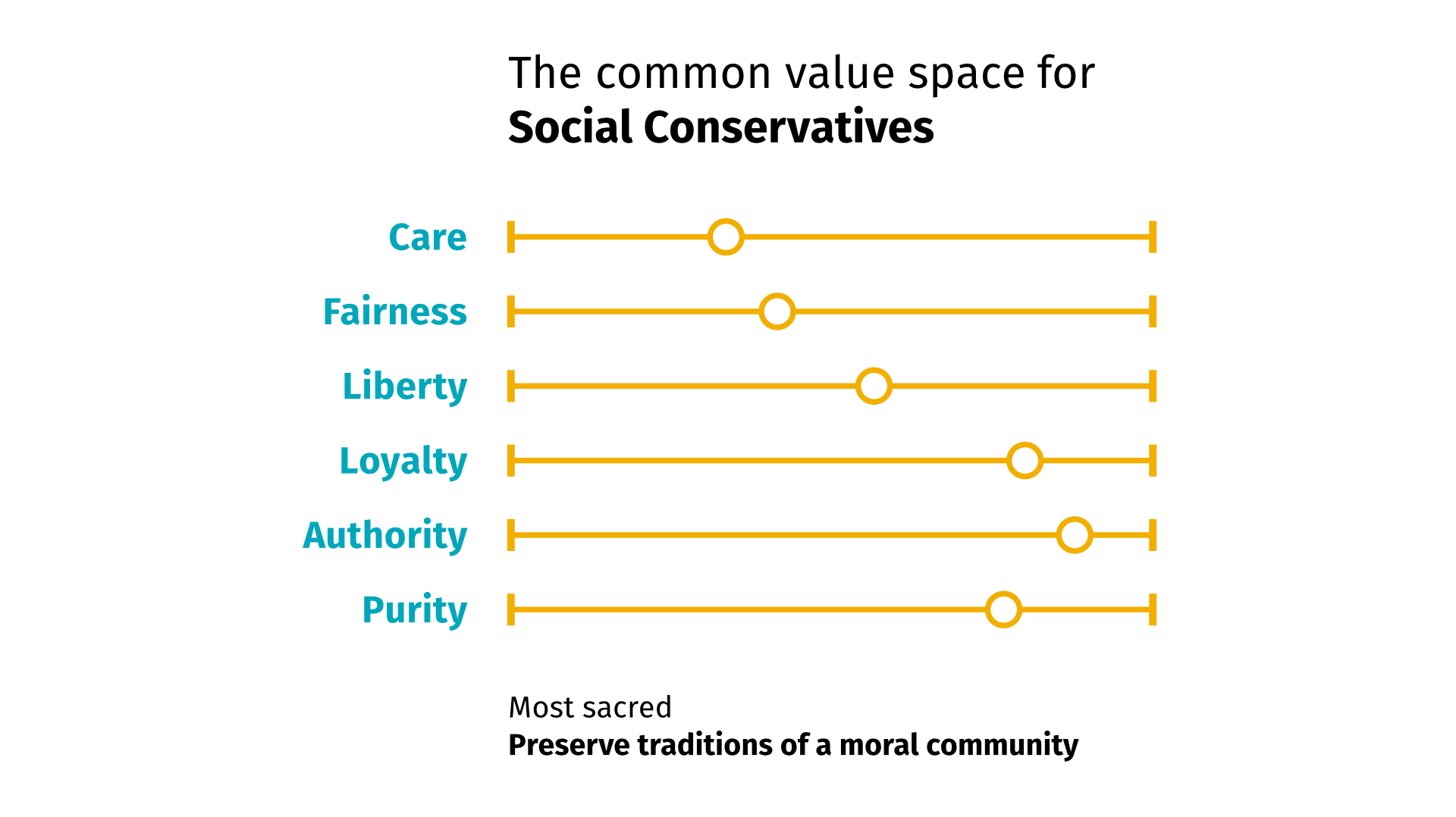1.3 Narrative space for your campaign
The first step of the narrative change planning process – Find a focus and opening - consists of five elements that guide you in the development of a campaign strategy. On this page, we focus on the third element - Narrative space for your campaign.
-
Target middle segment(s) & current frames/positions
-
Positive value map
-
Narrative space for your campaign
-
Opportunity or opening
-
Feasible campaign objectives
Elements 2, 3 and 4 in step 1 are interrelated and go together as a block: In order to arrive at a resonant space that engages the middle, campaigners need to:
- Map out the positive values that the target audience sees themselves promoting or defending in their views (1.2);
- Find a value overlap and choose a narrative space that is a suitable appeal for the organisation running the campaign (1.3); and
- which connects to an identified upcoming debate or event (1.4).
This is a kind of funnelling process that leads to a resonant messaging space (see the diagram on step 1.2). The next key part of the funnelling process in this element is to identify a value overlap and narrative space that you want to build your campaign on. This narrative space choice is not just about overlapping with the middle, but also requires you to be willing to message in public to the values behind the chosen narrative. We’ve organised this key decision around the two tasks fleshed out below.
Identify a value/messaging space that you can live with
Once a self-positive value map is developed for a segment, a very important question then arises: which values from the list would you/your organisation or coalition be willing to appeal to? In reaching out to the middle, there is usually a need to make an appeal to a more conservative value space than most progressives are used to doing. For example, in our two UK cases:
In his very informative analysis of the moral “taste buds” of liberals and conservatives, the moral psychologist Haidt details, as shown in the diagram below, that liberals tend to focus on issues of care, fairness and liberty with the core value as “care for victims of oppression”.

However, social conservatives focus on a broader base of values starting with care, fairness and liberty, but also adding loyalty, authority and purity. Bringing this together, their most sacred value is to “preserve the institutions and traditions that sustain a moral society”1 .

In the UK examples above, we can clearly see that the appeals are more towards this social conservative end with a focus on loyalty and purity (patriotism) in the British Future example and an appeal to liberty and purity (right to worship) in the Hope Not Hate campaign. So, this demonstrates that a move in this social conservative value direction is needed to really resonate and communicate effectively with the middle; but of course, it must be one that you are comfortable appealing to.
The table below adds five further campaign and messaging examples that move in a similar direction:
| Campaign | Message | Value Appeal | |
|
|
UK
|
|
|
| 1. | #WeAreAllEngland/British Future (Euro 2016 Football Tournament Campaign) |
“get people from all backgrounds in England to come together to celebrate our shared identity”. | Low-bar patriotism & community affiliation |
| 2. | A fair deal on migration for UK/Institute of Public Policy Research2 (Polling to test a fairness message in the public) | ‘If migrants work hard, pay in to the system, and uphold British values, we should welcome them to the UK.’ | Fairness, hard work, contribution and integration |
|
|
US
|
|
|
| 3. | Welcoming America – Reframing refugees3 | Moving is normal for both migrants and US citizens, so allow them to work, contribute to their communities and become citizens. | They do as we do (moving), work ethic, contribution and integration |
| 4. | Welcoming America – Stand Together4 : Messaging to Support Muslims and Refugees in Challenging Times | Freedom religion is a founding principle and now, people of all faiths needs to unite and stand together with open heats and compassion in welcoming new arrivals | Freedom of religion, humanitarianism and compassion |
| 5. | Frameworks institute – Finish the story on immigration5 (Research on messaging in the immigration reform debate) | Immigrants should be treated with compassion, but we need real solutions that offer a citizenship perspective, so that we can all benefit. | Humanitarianism, pragmatism and shared prosperity |
Most German campaigners we’re working with are very uncomfortable with an appeal to patriotism, but can see a more comfortable space in value appeals to community solidarity, local pride, the family, religious tolerance, and an inclusive idea of home or homeland. This is a core balancing act of building a solid foundation for your campaign that allows you to reach out and resonate with the middle and still focuses your message in a way to have the conversation you are happy with.
Beyond a willingness to move in this direction, it is also key that you are an authentic messenger. If the campaign goes well beyond the initial messaging, you will need to explain yourself and clearly stand behind the values you are defending and/or promoting. Further, you need to consider that a noticeable shift in your messaging could potentially alienate some of your existing supporters, partners or members. So, you either need to work hard to get your constituency on board with this movement outside the usual messaging space or consider a value appeal that would not be too far out of your comfort zone and not too alienating for your constituency.
Choose a value space that works for you and resonates with the middle
You may come up with a number of options of narrative areas you would want to take your campaign, but at this stage, you need to make a decision on the narrative direction for the campaign. This is the stage where you take the next step in the funnelling process of looking at the positive values that your segments are arguing, where you can find an overlap with those values that you are willing to message on and also the last step, how these connect to your target event or debate, which we consider in the next element.
Step 1.3: Narrative space for your campaign
-
What are the core values underpinning your migration work?
-
What values do you think you could build a message on when you look over the self-positive value map of your target segment(s)? Look back at your original list from element 1.2.
-
Which value appeals would you/your organization/coalition be happy to campaign on, and talk about in-depth, as part of the campaign?
-
How do you think your supporters, members and partners will respond? Will they understand and support your messaging choice/value appeal to social conservatives?
- 1 Haidt, Jonathon (2012) The righteous mind: Why good people are divided by politics and religion. New York: Pantheon Books.
- 2Institute of Public Policy Research (2014) A fair deal on migration for UK .
- 3Welcoming America (2015) Reframing refugees.
- 4Welcoming America (2016) Stand Together: Messaging to Support Muslims and Refugees in Challenging Times .
- 5FrameWorks Institute (2014) Finish the Story on Immigration: A FrameWorks Multi-Media Message Memo.